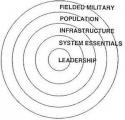The Air Force wasn’t thrilled about the Army-Marine Corps counterinsurgency document, which the service said gave short shrift to airpower’s capabilities, as proved in the ongoing counterinsurgency operations in Iraq and Afghanistan.
Maj. Gen. Allen G. Peck, commander of the Air Force Doctrine Center at Maxwell AFB, Ala., said he had seen the doctrine penned by Petraeus and Amos, and said that it reflected “a very two-dimensional view of how to fight a counterinsurgency.” If airmen had written it, it would be “different,” Peck observed.
The Air Force provides “maneuver” capabilities by backing up ground troops with kinetic and nonkinetic means, Peck noted.
The Air Force is working on its own COIN doctrine and is proposing to the Pentagon that a joint doctrine be developed. The Air Force version is on a fast track to be finished in August. The service is simultaneously pushing for a joint doctrine.
When that process is under way, “it will be helpful for us to have our Air Force doctrine in hand,” he said.
USAF agrees with Petraeus and Amos that air mobility is a powerful “asymmetric” capability and certainly endorses the view that ISR—air and space-based systems alike—are critical.
However, Peck said he was concerned about the doctrine’s tendency to low-rate the value of force applied from the air. He said FM 3-24 does “probably a bit too much hand-wringing over the potential for collateral damage,” because the Air Force exercises great care in selecting targets and uses the minimum explosive power possible to achieve the desired effect.













Bookmarks